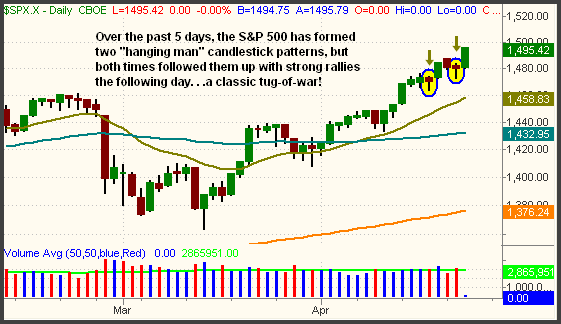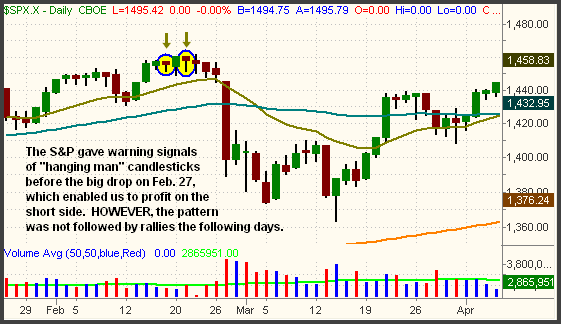| The Wagner Daily ETF Report for April 26 |
| By Deron Wagner |
Published
04/26/2007
|
Stocks
|
Unrated
|
|
|
|
The Wagner Daily ETF Report for April 26
An incredible 26% leap in Internet behemoth Amazon.com (AMZN) helped propel the Nasdaq Composite 0.9% and to a fresh six-year high. Both the S&P 500 and Dow Jones Industrial Average similarly gained 1.0%. The S&P 500 also set a new six-year high, while the Dow posted another historical high. As they have for most of the month, small and mid-cap issues lagged behind. The Russell 2000 and S&P Midcap 400 indices were higher by 0.7% and 0.8% respectively. Nevertheless, their gains were enough to caused both indexes to register new all-time highs. With the exception of some morning weakness, it was a steadily uptrending day that enabled all the major indices to close near their intraday highs.
This time, higher volume in both exchanges helped confirm the bullishness. Total volume in the NYSE increased by 2%, while volume in the Nasdaq swelled 17% above the previous day's level. Both the S&P and Nasdaq scored "accumulation days" that were indicative of institutional buying. One may wonder why the Nasdaq's turnover was so much better than the NYSE, yet both the S&P and Dow rallied more than the Nasdaq. Amazon's amazing volume spike was the culprit. On an average day, the stock trades between 6 to 7 million shares. However, more than 104 million shares of Amazon changed hands yesterday, single-handedly accounting for about 4% of the Nasdaq's higher turnover. Market internals were much stronger in the NYSE than in the Nasdaq. Advancing volume in the NYSE exceeded declining volume by just over 4 to 1. The Nasdaq was positive only by a ratio of approximately 3 to 2.
In yesterday's newsletter, we stated of Tuesday's action, "The S&P 500 formed a bearish "hanging man" candlestick pattern on the daily chart, but this does not necessarily mean the market will sell-off." Just as it did on April 20, the S&P followed up the April 24 "hanging man" with another surge to a new high. We have circled both "hanging man" candlesticks on the daily chart of the S&P 500 below:

If this candlestick pattern forms near the bottom of a protracted downtrend, it is actually a bullish candlestick known as a "hammer." However, it is a bearish signal known as a "hanging man" when it forms after a stock or index has been in a lengthy uptrend. The actual pattern indicates that the index sold off significantly intraday, but recovered to close near its opening high. The psychology behind why this pattern is considered to be bearish is that it indicates a trend may be getting tired and the bears are nibbling intraday. Just as an example, and not to say that history will necessarily repeat itself, notice how the S&P formed several "hanging man" candlesticks in the week preceding its big drop on February 27:

While this pattern is considered to be bearish when it forms after a lengthy uptrend, it is conversely bullish when it occurs at the bottom of a downtrend, as it hints at bulls "dipping a toe in the water" by supporting the market's close. But what about when an index forms a "hanging man" and subsequently follows-up the session with a surge to new highs the following day, as the S&P has done twice within the past five days? That simply tells us that the trend may be getting tired, but the bulls remain firmly in control. This conflicting pattern is one of the reasons we have been saying the stock market is showing a lot of mixed signals. Still, fighting the trend and attempting to sell short without lots of confirmation can be costly. Several times over the past month, the market promptly showed us the hard way that the current bull is not yet to be messed with.
What is a disciplined, professional trader to do when the Dow logically seems "overbought" by gaining 17 of the last 19 sessions, but still shows no clear signs of correcting? There are only two intelligent choices: continue going with the flow while keeping tight protective stops or sitting patiently in cash. We are now opting for the latter. Admittedly, we missed a bit of the recent bull run and found ourselves on the wrong side of the market too many times over the past month. However, blindly taking aggressive bull positions without waiting for a decent consolidation or pullback could easily compound the problem even more. For that reason, we're content to be flat right now, waiting for the next low-risk opportunities to buy.
Deron Wagner is the Founder and Head Trader of both Morpheus Capital LP, a U.S. hedge fund, and Morpheus Trading Group, a trader education firm launched in 2001 that provides daily technical analysis of the leading ETFs and stocks. For a free trial to the full version of The Wagner Daily or to learn about Wagner's other services, visit MorpheusTrading.com or send an e-mail to deron@morpheustrading.com.
|